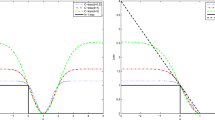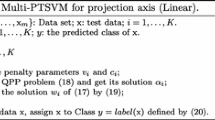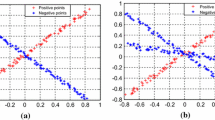Abstract
As an important multi-classification learning tool, multi-birth support vector machine (MBSVM) has been widely studied and applied due to its low computational complexity and good generalization. In this paper, a new multi-birth support vector machine is proposed to handle multi-class classification problem, called projection multi-birth support vector machine (PMBSVM). Specifically, we intend to seek a projection direction wk for k-th class, so that the covariance of remaining samples (except the k-th class) is as small as possible, and the samples of k-th class are as far as possible from the mean of the remaining samples. The proposed PMBSVM not only inherits the advantages of MBSVM, but also can find a suitable projection direction for each class so that the sample is separable in the projection space. Additionally, a regularization term is introduced to maximize the margin of different classes in the projected space. Moreover, a recursive PMBSVM algorithm is proposed for generating multiple orthogonal projection directions for each class. Then we extend the proposed approaches to nonlinear situations through kernel technology. Simulation results on benchmark datasets show that the proposed algorithms improve the generalization in most cases.





Similar content being viewed by others
References
Vapnik VN (1995) The Nature of Statistical Learning Theory. Statistics for Engineering and Information Science
Seehapoch T, Wongthanavasu S (2013) Speech emotion recognition using Support Vector Machines. 2013 5th International Conference on Knowledge and Smart Technology (KST), pp 86–91
Pai P, Hsu M, Wang M (2011) A support vector machine-based model for detecting top management fraud. Knowl-Based Syst 24:314–321
Shen L, Chen H, Yu Z, Kang W, Zhang B, Li HZ, Yang B, Liu D (2016) Evolving support vector machines using fruit fly optimization for medical data classification. Knowl-Based Syst 96:61–75
Keerthi SS, Shevade SK, Bhattacharyya C, Murthy KR (2001) Improvements to Platt’s SMO Algorithm for SVM Classifier Design. Neural Comput 13:637–649
Boser BE, Guyon I, Vapnik VN (1992) A training algorithm for optimal margin classifiers. Proc Ann Workshop Comput Learn Theory 5:144–152
Mangasarian OL, Wild EW (2006) Multisurface proximal support vector machine classification via generalized eigenvalues. IEEE Trans Pattern Anal Mach Intell 28:69–74
Shao Y, Deng N, Chen W, Wang Z (2013) Improved Generalized Eigenvalue Proximal Support Vector Machine. IEEE Signal Process Lett 20:213–216
Jayadeva KR, Chandra S (2007) Twin Support Vector Machines for Pattern Classification. IEEE Trans Pattern Anal Mach Intell 29:905–910
Shao Y, Zhang C, Wang X, Deng N (2011) Improvements on Twin Support Vector Machines. IEEE Trans Neural Netw 22:962–968
Kumar MA, Gopal M (2008) Application of smoothing technique on twin support vector machines. Pattern Recogn Lett 29:1842–1848
Peng X (2010) TSVR: An efficient Twin Support Vector Machine for regression. Neural Netw Official J Int Neural Netw Soc 23(3):365-72
Ghorai S, Mukherjee A, Dutta PK (2009) Nonparallel plane proximal classifier. Signal Process 89:510–522
Peng X (2010) Least squares twin support vector hypersphere (LS-TSVH) for pattern recognition. Expert Syst Appl 37:8371–8378
Xie J, Hone KS, Xie W, Gao X, Shi Y, Liu X (2013) Extending twin support vector machine classifier for multi-category classification problems. Intell Data Anal 17:649–664
Hastie TJ, Tibshirani R (1997) Classification by Pairwise Coupling. NIPS
Subirats JL, Jerez JM, Gómez I, Franco L (2010) Multiclass Pattern Recognition Extension for the New C-Mantec Constructive Neural Network Algorithm. Cogn Comput 2:285–290
Hao Z, Liu B, Yang X (2006) A Comparision of Multiclass Support Vector Machine Algorithms. 2006 International Conference on Machine Learning and Cybernetics, pp 4221–4226
Kressel U (1999) Pairwise classification and support vector machines
Yang Z, Shao Y, Zhang X (2012) Multiple birth support vector machine for multi-class classification. Neural Comput Appl 22:153–161
Xu Y, Guo R, Wang L (2012) A Twin Multi-Class Classification Support Vector Machine. Cogn Comput 5:580–588
Nasiri JA, Charkari NM, Jalili S (2014) Least squares twin multi-class classification support vector machine. Pattern Recognition 48(3)
Lima MD, Costa NL, Barbosa RM (2018) Improvements on least squares twin multi-class classification support vector machin. Neurocomputing 313:196–205
Belhumeur PN, Hespanha JP, Kriegman DJ, Aeigenfaces V (1996) Fisherfaces: recognition using class specific linear projection
Yang J, Yang J (2003) Why can LDA be performed in PCA transformed space?. Pattern Recogn 36:563–566
Bishop C (2006) Pattern recognition and machine learning. Springer, New York
Ye Q, Zhao C, Ye N, Chen Y (2010) Multi-weight vector projection support vector machines. Pattern Recogn Lett 31(13):2006–2011
Chen X, Yang J, Ye Q, Liang J (2011) Recursive projection twin support vector machine via within-class variance minimization. Pattern Recogn 44(10-11):2643–2655
Shao YH, Wang Z, Chen WJ, Deng NY (2013) A regularization for the projection twin support vector machine. Knowl-Based Syst 37(none):203—210
Vapnik VN (1998) Statistical learning theory. Wiley, New York
Müller K, Mika S, Rätsch G, Tsuda K, Schölkopf B (2001) An introduction to kernel-based learning algorithms. IEEE trans Neural Netw 12(2):181–201
Shao YH, Deng NY, Yang Z (2012) Least squares recursive projection twin support vector machine for classification. Pattern Recogn 45(6):2299–2307
Peng X, Chen D (2018) Ptsvrs: regression models via projection twin support vector machine. Inf Sci 435:1–14
Li CN, Huang YF, Wu HJ, Shao YH, Yang Z (2016) Multiple recursive projection twin support vector machine for multi-class classification. Int J Mach Learn Cybern 7(5):729–740
Mangasarian OL (1994) Nonlinear programming. SIAM
Blake CL, Merz CJ (1998) UCI Repository for machine learning databases. http://www.ics.uci.edu/mlearn/MLRepository.html
Acknowledgments
This work was supported in part by National Natural Science Foundation of China (No11471010) and Chinese Universities Scientific Fund.
Author information
Authors and Affiliations
Corresponding author
Additional information
Publisher’s note
Springer Nature remains neutral with regard to jurisdictional claims in published maps and institutional affiliations.
Rights and permissions
About this article
Cite this article
Wen, Y., Ma, J., Yuan, C. et al. Projection multi-birth support vector machinea for multi-classification. Appl Intell 50, 3040–3056 (2020). https://doi.org/10.1007/s10489-020-01699-z
Published:
Issue Date:
DOI: https://doi.org/10.1007/s10489-020-01699-z




